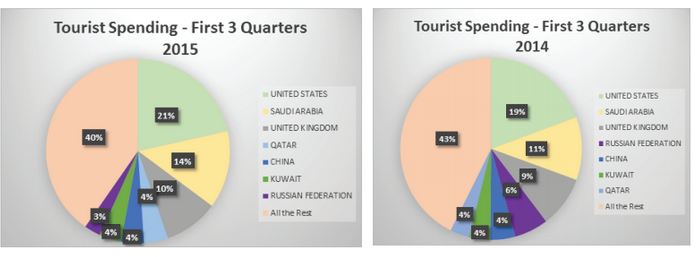- City Fajr Shuruq Duhr Asr Magrib Isha
- Dubai 04:20 05:42 12:28 15:53 19:08 20:30
Overall market spends in the UAE increased by 10 per cent in the first three quarters of 2015 as compared to the same period last year, according to a new report on consumer spends by payment solutions provider Network International.
The report, based on credit and debit card transactions in the UAE, found that growth in tourist spends for 2015 vs. 2014 turned positive for the first time in the third quarter of this year, bolstered by an increase in spending by the top three overall spenders – United States (15 per cent), Saudi Arabia (29 per cent) and United Kingdom (17 per cent).
In terms of nationalities, declines in overall Russian (-57 per cent) and Chinese spending (-20 per cent) was balanced by a 67 per cent growth in Qatari and 38 per cent growth in Nigerian spends across most sectors.
“The Q3 data indicates a major trend for local retailers – domestic and GCC spends, specifically Saudis and Qataris, have gained influence in the UAE markets displacing traditional top spenders such as the Chinese and Russians,” said David Mountain, Chief Commercial Officer, Network International.

The hospitality sector registered strong year-on-year growth, an 8 per cent increase in Q3 2015 as compared to Q3 2014. This growth, however, was not due to increase in RevPAR and average per purchase spends in Q3 2015 declined 6 per cent vs. Q3 2014.
Hotels continued to feel the impact of the decline in Russian tourists as spends decreased 48 per cent in Q3 2015 vs. Q3 2014. However, this was balanced by a 90 per cent growth in spends from Qataris and UK and Saudi spends growing at 23 and 25 per cent, respectively, in Q3 2015 vs. Q3 2014.
Luxury takes a fall
The luxury sector, comprising jewellery and expensive watches, took a plunge in 2015 due to their significant reliance on Chinese and Russians, who used to account for more than 25 per cent of the overall tourist spend last year.
A comparison of Q3 2015 vs Q3 2014 spends data reveals that the US and Chinese declined spends by 23 and 57 per cent, respectively. Among the top 10 spenders – British (9 per cent), Saudis (19 per cent) and Qataris (74 per cent) – stemmed the tide with a healthy positive growth in Q3 2015 vs. Q3 2014.
Overall, the sector is witnessing 7 per cent average decline in 2015 vs 2014 and 1 per cent decline in Q3 2015 vs Q3 2014. With the Chinese economy still not showing signs of economic recovery, and with low oil prices and sanctions on Russian economy, growth in the sector can be expected to remain sluggish in the near term.
Fashion sees change
A lot has been happening in the clothing/fashion sector. The sector turned positive (4 per cent growth) for the first time in Q3 2015. While domestic spends grew moderately by 5 per cent year on year, most of the overall growth was contributed by Saudis (33 per cent), Qataris (68 per cent) and Nigerians (87 per cent) in Q3 2015.
Russians (-74 per cent) were replaced by Saudis as the one of the top tourist spenders. Egyptians and Kazakhstanis are among the other top 10 tourist spenders in this sector. As in the hospitality sector, Qatar once again fortified spends with a 68 per cent hike in Q3 2015 vs Q3 2014.
Gains in F&B sector
One of the major sectors which witnessed a staggering growth was F&B (30 per cent in absolute numbers) year-on-year. Growth in this sector was distributed with almost all nationalities performing well, with the top five being Saudi Arabia, UK, US, Kuwait and Qatar.
78 per cent growth in Saudis spending in F&B sector have moved them to the top spender group, followed closely by Qatar (133% growth in spends) and 30 per cent growth in domestic spends in Q3 2015 vs Q3 2014.
F&B’s success has prompted all major hotels to focus on this rapidly evolving sector especially at a time when RevPAR is much lower than past.
![]() Follow Emirates 24|7 on Google News.
Follow Emirates 24|7 on Google News.